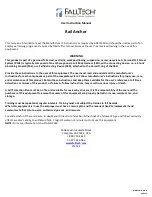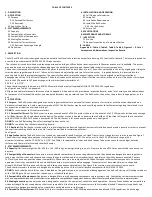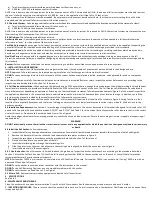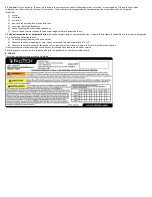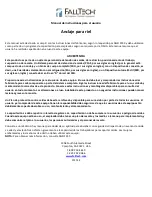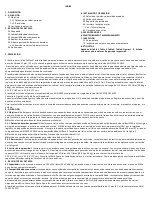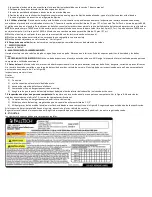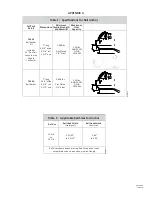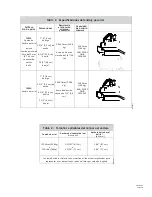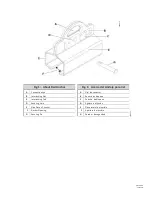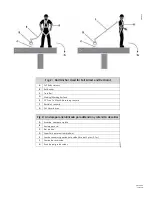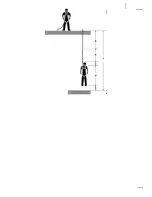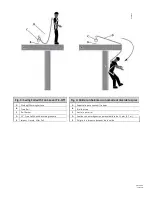
TABLE OF CONTENTS
1.
DESCRIPTION
2.
APPLICATION
2.1
Purpose
2.1.1
Personal Fall Arrest:
2.1.2
Restraint
2.3 Application Limits
3.
SYSTEM REQUIREMENTS
3.1
Capacity
3.2
Compatibility of Connectors
3.3
Compatibility of Components
3.4
Making Connections
3.5
Personal Fall Arrest System
3.5.1
Restraint Anchorage Strength
3.6
Definitions
1. DESCRIPTION
4.
INSTALLATION AND OPERATION
4.1
Fall Clearance Calculation:
4.2
Swing Fall
4.3
Installation Requirements
4.4
Install the Rail Anchor
4.4.1 Use the Anchor
4.5
After a Fall
5.
SPECIFICATIONS
6.
MAINTENANCE AND STORAGE
7.
INSPECTION
7.1
Pre-Use
7.2
Annual Inspection by a Competent Person
8.
LABELS
Appendix A - Table 1, Table 2, Table 3, Table 4, Figures 1 – 9, List of
Acronyms and Abbreviations, Inspection Record
The FallTech® Rail Anchor is designed to provide a mobile foot level fall protection anchor for attaching a 12 foot free fall lanyard. The lanyard required for
use with this anchor meets ANSI Z359.13-2013 requirements.
The rail anchor is used by railroad maintenance personnel on bridges, cliffs and other locations where fall hazards exist and rail is available. The anchor
may also be used as a restraint anchor depending upon the workplace geometry and the available restraint system components.
The anchor is composed of two formed steel side plates that are placed on both sides of a rail. The anchor is attached to the rail by aligning and sliding the
two side plates together over the rail. Tabs and slots in each side plate align and join to form the anchor. A supplied detent pin is inserted into the
securing hole to lock the two plates together. The specially shaped fall protection connecting eye at the top is designed to inhibit unintentional
disengagement of the 12-foot free fall lanyard. The anchor is open at the bottom to allow it to slide in either direction on the rail. The anchor fits railroad
rails in the 112 pounds to 141 pounds range, with minimum/maximum widths of
2-23/32 " to 3-1/16".
The anchor discussed in this manual is ANSI Z359 compliant and meets all applicable OSHA 29 CFR 1926.502 regulations.
See Figure 1 and Table 1 in Appendix A.
All figure and table references in this manual are to Appendix A. Appendix A also provides an Inspection Record, and a list of acronyms and abbreviations.
For purposes of this manual the anchor and associated fasteners may be referred to as The Rail Anchor, the anchor, the product, the equipment, or the
unit.
2.
APPLICATION
2.1
Purpose:
The Rail Anchor is designed as an anchorage attachment for a personal fall arrest system or for restraint, with the anchor deployed on a
horizontal railroad track rail, with a maximum grade of 15%. The Rail Anchor may be used as a sliding anchor to facilitate moving along the railroad track
for inspection or repair on a rail bed or bridge.
DO NOT
use the anchor to lift tools or materials.
2.1.1
Personal Fall Arrest:
The Rail Anchor is used as a component of a PFAS to protect the user in the event of a fall. PFAS typically include an anchorage,
a Full Body Harness (FBH), and a deceleration device. The anchor may only be used to traverse the rail with an 12 foot free fall lanyard that is compliant
with ANSI Z359.13-2013, FallTech part number 8248. The Rail Anchor is for use above the grade only. See Figure 2.
DO NOT
use a Self-Retracting Device for travel applications on the rail.
DO NOT
use a 6 foot free fall shock-absorbing lanyard.
2.1.2
Restraint:
The Rail Anchor may be used in a restraint application. Restraint applications typically include an anchor and a lanyard or tether to prevent
the user from reaching a fall hazard area. No free fall is permitted in restraint applications.
See Figure 2.
2.3 Application Limits:
The Rail Anchor is not suited nor approved for head-free type rail. Head-free rail has a triangular cross section shape. See Figure 7.
The anchor is not designed to pass over rail splices. Rail slope must not exceed 15%. Use only on rail in the 112-141 lbs/ yard range, with a
minimum/maximum width of 2-23/32" to 3-1/16". See Table 2 for applicable rail sizes and head shapes. Take action to avoid sharp edges, abrasive
surfaces, and thermal, electrical and chemical hazards.
3.
SYSTEM REQUIREMENTS
3.1
Capacity:
Limit user weight to 130 – 310 lbs., (59 – 140.6 kg), including clothing, tools, etc. No more than one PFAS may be attached to an anchor at
any time.
3.2
Compatibility of Connectors:
Connectors are considered compatible with connecting elements when they have been designed to work together in
such a way that their sizes and shapes do not cause their gate mechanisms to open inadvertently, regardless of how they become oriented. Contact
FallTech if you have any questions about compatibility. Connectors must be compatible with the anchorage or other system components. Do not use
equipment that is not compatible. Non-compatible connectors may unintentionally disengage. Connectors must be compatible in size, shape, and
strength. ANSI and OSHA require self-closing, self-locking snap hooks and carabiners. See Figure 9 for common incorrect connections to avoid.
The anchor discussed in this manual is designed to be used only with a 12-foot free fall lanyard compliant with ANSI Z359.13-2013.
DO NOT
attach rebar hooks to this anchor. A side load on the gate may cause an unintentional disengagement. Use only self-closing, self-locking carabiners
with a 5,000lb gate. Do not use swivel, captive-eye, or standard carabiners.
3.3
Compatibility of Components:
Equipment is designed for use with approved components and subsystems only. Substitutions or replacements made
with non-approved components or subsystems may jeopardize compatibility of equipment and may affect the safety and reliability of the complete system.
3.4
Making Connections:
Use only connectors designed for use with this equipment, suitable to each application. Ensure all connections are compatible in
size and strength. Do not use equipment that is not compatible. Visually ensure all connectors are fully closed and locked. Connectors (snap hooks and
carabiners) are designed to be used only as specified in each product’s user instructions.
3.5
Personal Fall Arrest System:
PFAS used with the rail anchor must meet ANSI Z359 requirements and applicable OSHA regulations. An anchorage

